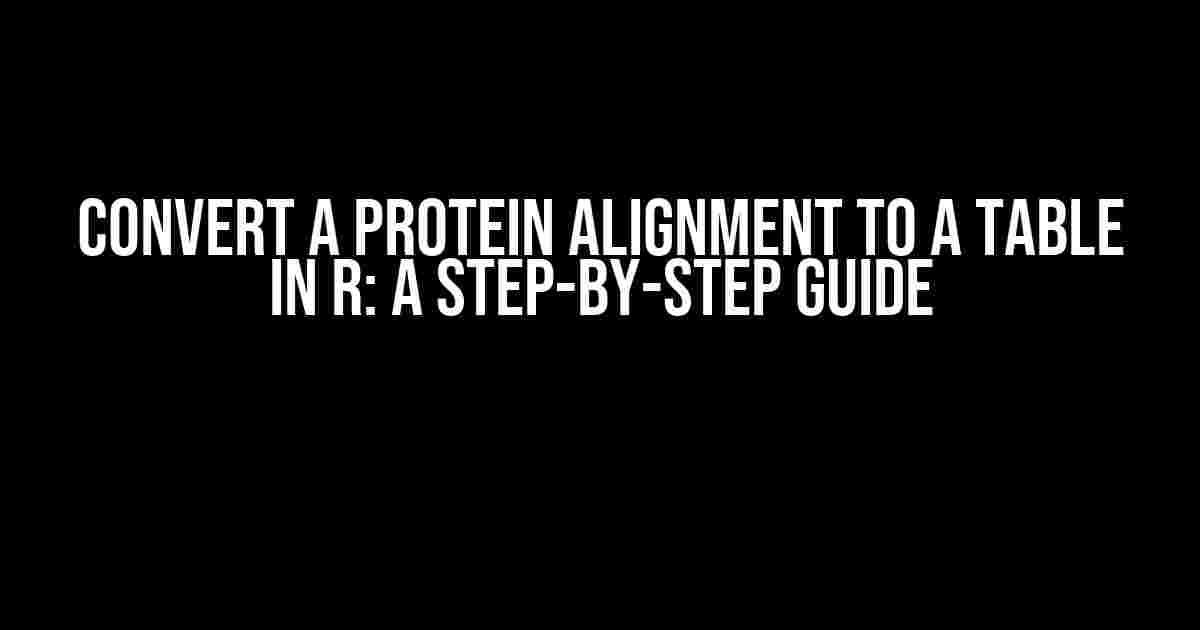Are you tired of staring at a messy protein alignment file, wondering how to make sense of it all? Do you wish you could easily compare and analyze your data in a neat and organized table? Well, wonder no more! In this article, we’ll show you how to convert a protein alignment to a table in R, step-by-step.
- What is a Protein Alignment?
- Why Convert a Protein Alignment to a Table?
- Step 1: Install and Load the Required Packages
- Step 2: Read in the Protein Alignment File
- Step 3: Convert the Alignment to a Matrix
- Step 4: Convert the Matrix to a Data Frame
- Step 5: Clean Up the Data Frame
- The Final Product
- What’s Next?
- Conclusion
What is a Protein Alignment?
Before we dive into the tutorial, let’s take a quick detour to explain what a protein alignment is. A protein alignment is a way of comparing multiple amino acid sequences to identify similarities and differences between them. This is particularly useful in bioinformatics, where researchers want to analyze the evolutionary relationships between different proteins or identify functional regions within a protein.
Why Convert a Protein Alignment to a Table?
So, why bother converting a protein alignment to a table? Well, for starters, tables are much easier to work with than alignment files. With a table, you can easily:
- Compare and contrast different protein sequences
- Identify patterns and trends in your data
- Perform statistical analyses and create visualizations
- Share your results with colleagues and collaborators
In short, converting a protein alignment to a table makes it easier to explore, analyze, and understand your data.
Step 1: Install and Load the Required Packages
Before we begin, make sure you have the following R packages installed:
install.packages("Biostrings")
install.packages("seqinr")
Once installed, load the packages:
library(Biostrings)
library(seqinr)
Step 2: Read in the Protein Alignment File
Next, read in your protein alignment file using the read.phyDat() function from the seqinr package:
# Replace "alignment.phy" with your file name
alignment <- read.phyDat("alignment.phy", format = "phylip")
This will load your alignment file into R as a phylDat object.
Step 3: Convert the Alignment to a Matrix
Now, convert the alignment object to a matrix using the as.matrix() function:
alignment_matrix <- as.matrix(alignment)
This will create a matrix where each row represents a protein sequence, and each column represents a position in the alignment.
Step 4: Convert the Matrix to a Data Frame
Next, convert the matrix to a data frame using the as.data.frame() function:
alignment_df <- as.data.frame(alignment_matrix)
This will create a data frame where each row represents a protein sequence, and each column represents a position in the alignment.
Step 5: Clean Up the Data Frame
Finally, let's clean up the data frame by renaming the columns and adding a column for the protein names:
colnames(alignment_df) <- paste0("Position_", 1:ncol(alignment_df))
rownames(alignment_df) <- alignment@row.names
alignment_df <- cbind(Protein = rownames(alignment_df), alignment_df)
This will create a neat and organized data frame with clear column names and a column for the protein names.
The Final Product
And that's it! You've successfully converted a protein alignment to a table in R. Here's an example of what the final product might look like:
| Protein | Position_1 | Position_2 | ... | Position_n |
|---|---|---|---|---|
| Protein_A | A | R | ... | L |
| Protein_B | G | K | ... | V |
| Protein_C | S | T | ... | I |
What's Next?
Now that you've converted your protein alignment to a table, the possibilities are endless! You can:
- Perform statistical analyses, such as calculating pairwise distances or identifying conserved regions
- Create visualizations, such as heatmaps or phylogenetic trees, to explore your data
- Share your results with colleagues and collaborators, or publish them in a scientific journal
- Integrate your data with other bioinformatics tools and pipelines
The key is to be creative and explore different ways to analyze and visualize your data.
Conclusion
In this article, we've shown you how to convert a protein alignment to a table in R, step-by-step. By following these instructions, you can easily analyze and understand your protein alignment data. Remember to be creative and explore different ways to analyze and visualize your data – and happy bioinformatics-ing!
Keywords: protein alignment, R, table, bioinformatics, data analysis, visualization
Frequently Asked Question
Are you stuck trying to convert a protein alignment to a table in R? Worry no more! Here are the answers to the most frequently asked questions to get you started.
Q1: What is the best way to import a protein alignment file into R?
You can use the read.phylo() function from the ape package in R to import a protein alignment file in PHYLIP format. For example: library(ape); align <- read.phylo("alignment.phy", "phylip")
Q2: How do I convert a protein alignment object to a data frame in R?
You can use the as.matrix() function to convert the alignment object to a matrix, and then use the as.data.frame() function to convert the matrix to a data frame. For example: align_matrix <- as.matrix(align); align_df <- as.data.frame(align_matrix)
Q3: Can I specify the column names for the data frame?
Yes, you can specify the column names using the colnames() function. For example: colnames(align_df) <- paste0("Sequence_", 1:ncol(align_matrix)). This will assign column names as "Sequence_1", "Sequence_2", etc.
Q4: How do I handle gaps in the alignment when converting to a table?
You can remove gaps from the alignment before converting to a table using the gapless() function from the ape package. For example: align_gapless <- gapless(align); align_df <- as.data.frame(as.matrix(align_gapless))
Q5: Can I customize the appearance of the table in R?
Yes, you can use various packages such as DT, formattable, or kable to customize the appearance of the table in R. For example, you can use the DT package to create an interactive table: library(DT); datatable(align_df).
